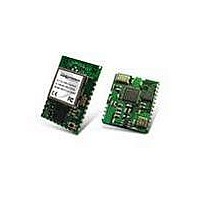WI.232FHSS-250-R Radiotronix, WI.232FHSS-250-R Datasheet - Page 16

WI.232FHSS-250-R
Manufacturer Part Number
WI.232FHSS-250-R
Description
RF Modules & Development Tools 900MHz FHSS Low
Manufacturer
Radiotronix
Datasheet
1.WI.232FHSS-25-FCC-RA-R.pdf
(67 pages)
Specifications of WI.232FHSS-250-R
Lead Free Status / RoHS Status
Lead free / RoHS Compliant
Other names
WI232FHSS-250-R
WI.232FHSS-25-R/ WI.232FHSS-250-R DATASHEET
2.4.1. GUID/MAC Mode
GUID/MAC mode supports point-to-point and broadcast communications. In this mode, endpoint addressing
is accomplished through the
GUID (regMYGUID[3-0]) is fixed and programmed at the factory. MAC addressing mode is selected by
writing either 0x04 (MAC) or 0x14 (MAC w/ acknowledgement) to the
destination GUID of 0xFFFFFFFF causes the module to send broadcast messages; all modules within range
will receive and process these messages. A module will only process a MAC message if the message’s
destination address is 0xFFFFFFFF or it exactly matches its
enabled by setting bit 4 of regNETWORKMODE. The GUID/MAC network mode includes 14 bytes of
overhead per RF packet. The following table lists some examples of how MAC addressing works.
Table 2, MAC Addressing Examples
2.4.2. User Addressing Mode
When User network mode is selected, transmitted packets locate endpoints using the customer ID and
destination User ID (specified in
sent with User Network mode enabled carries 16 bytes of overhead. On the receiving side, each module has
a User ID mask (regUSERIDMASK[1..0]) that it applies to both its own User ID (regUSERSRCID[1-0]) and
the incoming destination User ID. Once both are masked, if the results are equal, the receiving module will
pass the payload data to the application for presentation to the host. Additionally, if the incoming address,
once masked, equals the mask itself, its payload will be presented to the host. If an acknowledgement is
requested, the receiving module will respond only if the unmasked User IDs are equal. When using user
network mode to send packets to multiple users (mask not equal to 0xFFFF), assured delivery must be
disabled. Failure to do so could cause extreme delays in transmission and loss of data. The following table
shows some examples of user addressing at work.
Sender
NetworkMode
0x04
0x14
0x14
0x04
Sender
Network
Mode
0x06
0x16
0x16
User
SRCID
0x1000
0x1000
0x1000
MyGUID
0x00001000
0x00001000
0x00001000
0x00001000
User
DESTID
0xFFFF
0xFFFF
0x3000
regNVDESTGUID[3-0]
regCUSTID[1-0]
DestinationGUID
0xFFFFFFFF
0xFFFFFFFF
0x00003000
0x00002000
Receiver
User SRCID
0x2000
0x3000
0x2000
0x3000
0x2000
15
and regUSERDESTID[1-0], respectively). An RF packet
and
Receiver
MyGUID
0x00002000
0x00003000
0x00002000
0x00003000
0x00002000
0x00003000
0x00002000
0x00003000
User
IDMASK
0xFFFF
0xFFFF
0xFFFF
0xFFFF
0xE000
regDESTGUID[3-0]
regMYGUID[3-0]
regNETWORKMODE
Response
Data sent to UART. No RF ACK
sent by either module.
Data sent to UART in both
modules. No ACK sent by either
module. This configuration will
cause transmission problems.
Data sent to UART. No RF ACK
sent.
Response
Data sent to UART. No RF
ACK sent by either module.
Data sent to UART. No ACK
sent by either module. This
configuration will cause
transmission problems.
Not processed- discarded.
Data sent to UART. RF ACK
sent to 0x00001000.
Data sent to UART. No RF
ACK sent.
Not processed- discarded.
registers. The module’s source
address. Acknowledgement is
register. A
Revision 1.1.0













